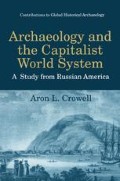Abstract
Historical archaeology is the “archaeology of capitalism” (Paynter 1988), including its evolution and expansion, economic and social impacts, and the material culture of the industrial age. As an integrated world system of capitalist economies coalesced during the late eighteenth century, Russian fur merchants pushed eastward from Siberia to Alaska, subordinating new peoples into global hierarchies of production, consumption, and power (Wallerstein 1974; Wolf 1982). The present study examines this momentous expansion from a single point in space and time–the Russian settlement at Three Saints Harbor on Kodiak Island, Alaska, founded by fur merchant Grigorii Shelikhov in 1784. Despite its small size and relatively brief span of occupation, Shelikhov’s outpost in America is a rich source of historical and archaeological information pertaining to the origins and development of Russian colonialism, and about the material ties between Russia and its distant Alaskan frontier. Studies at Three Saints address topics of broad significance to historians and anthropologists as they attempt to interpret the complex interactions that everywhere accompanied Western contact and capitalist transformation.
Access this chapter
Tax calculation will be finalised at checkout
Purchases are for personal use only
Preview
Unable to display preview. Download preview PDF.
References
Qikertarmiut (“people of the island”) is a self-designation for the Native population of the Kodiak archipelago (Pullar 1994:23). The Qikertarmiut were called Kaniagi by the Russians (an Aleutian Islands term, Americanized to Koniags), and also “Kadiak Aleuts” or simply “Aleuts.” Alutiiq (plural Alutiit) has long been in use among the Alaska Native population (and more recently among anthropologists) as a designation for the indigenous language of the region (also known as Sugpiaq or Sugcestun) and as a general term for the culturally related populations of the Kodiak archipelago, the Alaska Peninsula, lower Cook Inlet, the outer Kenai coast, and Prince William Sound. Alutiiq is synonymous with Pacific Eskimo, a classificatory term adopted by ethnologists to emphasize the close linguistic and cultural affiliations between the coastal peoples of the Gulf of Alaska and their Yup’ik (Eskimo) neighbors to the north (Clark 1984b).
Author information
Authors and Affiliations
Rights and permissions
Copyright information
© 1997 Springer Science+Business Media New York
About this chapter
Cite this chapter
Crowell, A.L. (1997). Russian America and the Archaeology of Capitalism. In: Archaeology and the Capitalist World System. Contributions to Global Historical Archaeology. Springer, Boston, MA. https://doi.org/10.1007/978-1-4757-9279-9_1
Download citation
DOI: https://doi.org/10.1007/978-1-4757-9279-9_1
Publisher Name: Springer, Boston, MA
Print ISBN: 978-1-4757-9281-2
Online ISBN: 978-1-4757-9279-9
eBook Packages: Springer Book Archive

